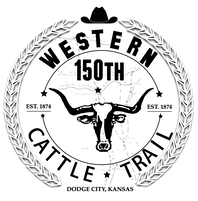|
The Kansas Cow Town grew out of necessity to satisfy man's needs. In addition, cattle were to provide these towns with their chief means of support in the two decades the cattle business endured. During this time, some five to six million cows parted through the myriad shipping points on their way to the market. Of the many towns that grew up around this thriving enterprise, only four or five ever received national prominence as wild and woolly cowtowns. One is Dodge City.
The few existing settlements catered to the appetites of buffalo hunters. Dodge City, Kansas, called initially "Buffalo City," was an example. New contenders within the new settlement acknowledged that the buffalo were disappearing and that the buffalo-hunter town needed a new raison d’être (a purpose for making a living), or they would die. The business leadership of Dodge City vigorously advertised the town's wide-open character, its open range, and its flexible enforcement of laws regulating gambling, prostitution, and public drunkenness. It already had a full-bodied gambling, drinking, and prostitution infrastructure to nurse the buffalo hunters, and it was just a matter of discovering new customers. This would be the cowboys associated with the cattle drives coming up the newly established Western trail that would provide prosperity. When they learned that Dodge City's preparatory role was to serve as a supply point and way station for herds, city organizers mustered to form future business ventures to keep the cattle drives from circling the western end of town; a plan was needed to lure cowboys into local establishments before moving on to Ogallala. As the cattle-shipping season of 1876 loomed, Dodge City townsmen braced for a new economic opportunity. They formed a special council on Christmas Eve of 1875. This particular council of businessmen men met to appoint provisional officials. These selected men were to hold office until a municipal election was planned for the following April. The special counsel immediately parted in differences, and on Christmas Eve of 1875, Dodge City became a divided town. The division came when one of the members of the individual committees proposed the idea of ordnances. He stated, "We should have an ordinance prohibiting the firing of guns within the city limits. He continued to make his point by stating, "I also believe we should have a law not allowing the riding of horses over sidewalks and into the saloons." A bitter debate broke out. Those businessmen who hungered after the cattlemen's trade strongly opposed any restrictions on the Cowboys. This side of the discussion feared the cattlemen would look elsewhere for a shipping point. Heading this group was Bob Wright, the former Fort Dodge sutler, whose general store partnered with Charlie Rath, one of the first businesses established in Dodge City. In 1876 and for many years, Bob Wright was Dodge City's most prosperous businessman. Allied with Wright were James H. ("Dog") Kelley and his partner, Peter L. Beatty, proprietors of the Alhambra Saloon, Gambling Hall, and Restaurant. George B. Cox, another early arrival, always sided with the Wright forces. Cox came to Dodge City from Larned in 1872 and built the thirty-eight-room Dodge House, which opened on January 18, 1873. Opposing the Dodge City Gang was a group of men who proclaimed to stand for law and order, led by wholesale liquor dealer George M. Hoover. Physician Sam Galland, lawyer Dan M. Frost, and livery stable owner Ham Bell were preeminent in this faction. Hoover was a Dodge pioneer, having sold whiskey to the soldiers from Fort Dodge in a tent on the townsite as early as 1871. Galland, Frost, and Bell did not establish residence until 1874. However, early settlers Wright, Kelley, Cox, and others considered them johnnies-come-lately and resented their attempts to change the town's character. Peter L. Beatty was selected as acting mayor. Beatty served as Mayor from the December 1875 meeting of town leaders until April 1876. Dodge City, however, was about the limit of westward shifts of the cattle drives. Dodge was in the middle of the prairie, providing thousands of acres of grassland for cattle to fatten on while they waited for their trains to the East and recovered from the cattle drive to Dodge. Fredric R. Young, in his book "Dodge City: Up through the Century," explained in 1972 an advertisement that appeared in the Dodge City Times as a means to draw the cattle trade to Dodge City:
0 Comments
Leave a Reply. |
Author"THE MISSION OF THE WESTERN CATTLE TRAIL ASSOCIATION IS TO PROTECT AND PRESERVE THE WESTERN CATTLE TRAIL AND TO ACCURATELY PROMOTE AWARENESS OF IT'S HISTORICAL LEGACY." Archives
July 2024
Categories |



 RSS Feed
RSS Feed

